Unit 2: Sensory Systems
0.0(0)
Card Sorting
1/101
Earn XP
Description and Tags
Study Analytics
Name | Mastery | Learn | Test | Matching | Spaced |
|---|
No study sessions yet.
102 Terms
1
New cards
sensory feedback enables us to not only interact with our environment, but make ____ based on interactions
adjustments
2
New cards
prediction (predict what’s going to happen, usually by sight)
feedforward control
3
New cards
response (response to prediction)
feedback control
4
New cards
theory of feedback control
goals → feedforward controller → controlled system → feedback loop → feedback controller → controlled system
5
New cards
what is the goal in the AC unit example?
keeping a constant temperature
6
New cards
what is the feedforward controller in the AC unit example?
individual
7
New cards
what is the controlled system in the AC unit example?
AC unit
8
New cards
what is the feedback controller in the AC unit example?
thermostat
9
New cards
what is the disturbance in the AC unit example?
window opens
10
New cards
what is the goal in the muscle spindle example?
keep elbow flexed at 90°
11
New cards
what is the feedforward controller for the muscle spindle example?
brain
12
New cards
what is the feedback controller for the muscle spindle example?
muscle spindle
13
New cards
what is the controlled system in the muscle spindle example?
arm (body)
14
New cards
what is the controlled variable in the muscle spindle example?
muscle length
15
New cards
what is the disturbance in the muscle spindle example?
weight is dropped into hand
16
New cards
step 1 of optimal feedback control
brain sends out command
17
New cards
step 2 of optimal feedback control
movement
18
New cards
step 3 of optimal feedback control
detect error (sensory feedback)
19
New cards
step 4 of optimal feedback control
compare to original ‘out’ signal
20
New cards
step 5 of optimal feedback control
make changes (position, velocity, force)
21
New cards
step 6 of optimal feedback control
repeat task, improved performance
22
New cards
where does all sensory information come in?
backside of dorsal horn
23
New cards
short-latency reflex (simple)
* fast
* dumb
* 20 - 50 ms after event
* mutable (somewhat)
* dumb
* 20 - 50 ms after event
* mutable (somewhat)
24
New cards
SLR pathway
limb (muscle) → spinal cord → limb (muscle)
25
New cards
long latency reflex (complex)
* slower
* smart (\~voluntary, decision based)
* 50 - 100 ms after event
* mutable (persistent)
* smart (\~voluntary, decision based)
* 50 - 100 ms after event
* mutable (persistent)
26
New cards
LLR pathway
limb (muscle) → spinal cord → brain → spinal cord → limb (muscle)
27
New cards
rostral
up
28
New cards
caudal
down
29
New cards
ventral
front
30
New cards
dorsal
back
31
New cards
fine touch and proprioception
travels up the medial lemniscal tract to the decussation, where it travels contralaterally
32
New cards
course touch, pain, and temperature
travels up anterolateral tract to the decussation where it travels contralaterally
33
New cards
gracile nucleus
touch and proprioception for the lower body
34
New cards
cuneate nucleus
touch and proprioception for the upper body
35
New cards
where is sensory information relayed through?
the thalamus to the somatosensory cortex
36
New cards
both group I and II afferents carry information from where?
muscle spindle
37
New cards
static component of muscle spindles
sustained stretch
38
New cards
dynamic component of muscle spindles
transient changes in length
* dynamic nuclear bag fibers
* ONLY Ia afferents carry these
* dynamic nuclear bag fibers
* ONLY Ia afferents carry these
39
New cards
what is the static component of muscle spindles and what afferents do they carry?
static nuclear bag and nuclear chain fibers
* both carry group Ia and II afferents
* both carry group Ia and II afferents
40
New cards
muscle spindles detect what?
changes in muscle length (stretch reflexes)
* both the amount and rate of change
* both the amount and rate of change
41
New cards
why is the muscle spindle organization of muscle fibers important?
in-parallel; to detect muscle length changes by lying next to contractile muscle fibers
\
1 muscle spindle to 3-4 contractile fibers
\
1 muscle spindle to 3-4 contractile fibers
42
New cards
monosynaptic
one synapse
* the sensory neuron synapses directly onto the motor neuron in the spinal cord
* the sensory neuron synapses directly onto the motor neuron in the spinal cord
43
New cards
what afferents largely make a monosynaptic connection in the spinal cord?
Ia and II afferents
44
New cards
monosynaptic reflex
direct communication between sensory and motor neurons
45
New cards
how do we keep muscle spindles tight?
gamma motor neurons
* keep the muscle spindle tight and ready to respond
* keep the muscle spindle tight and ready to respond
46
New cards
tendon tap
used for clinical assessment of stretch reflexes
47
New cards
proprioception
status of the body internally
48
New cards
how can joint positions be manipulated?
* chemicals: lidocaine nerve block
* ischemia: mechanically compressing nerve
* tendon vibration: overexciting muscle spindles
* muscle fatigue
* ischemia: mechanically compressing nerve
* tendon vibration: overexciting muscle spindles
* muscle fatigue
49
New cards
ischemia
mechanically compressing the nerve that we do not get Ia afferent signals back to the spinal cord
* can alter joint position sense
* can alter joint position sense
50
New cards
tendon vibration
overexcites causing the muscle spindles to fire at a high rate
51
New cards
muscle fatigue
muscle spindles fatigue causing more error in joint position sense
* as you lose proprioception as you fatigue, more likely an injury can occur
* as you lose proprioception as you fatigue, more likely an injury can occur
52
New cards
hold relax stretching technique
maximally activate muscle and then relax and stretch
* harder to elicit a stretch reflex for up to 15s following a contraction (momentarily muscle fatigue)
* fatiguing the muscle spindles
* harder to elicit a stretch reflex for up to 15s following a contraction (momentarily muscle fatigue)
* fatiguing the muscle spindles
53
New cards
agonist contract
by contracting the opposite (antagonist) muscle in which you want to stretch \~ it shuts off the spinal circuit of the muscle you want stretched (agonist) allowing it to relax
54
New cards
plasticity in the stretch reflex (Ia muscle spindle circuits)
with sufficient practice, even a simple stretch reflex can be modified
* example: walking backwards on treadmill
* stretch reflexes are ramped up because protecting you from the expectations of falling
* 2 weeks later: fairly consistent as if you were to walk forward, this is a learning process
* less expectations to fall by the end of 2 weeks and less protective
* example: walking backwards on treadmill
* stretch reflexes are ramped up because protecting you from the expectations of falling
* 2 weeks later: fairly consistent as if you were to walk forward, this is a learning process
* less expectations to fall by the end of 2 weeks and less protective
55
New cards
what is a negative effect of stretch reflexes following a stroke?
hyperreflexia or spasticity
56
New cards
what are the 4 types of touch receptors?
* meissner’s corpuscles
* merkel’s disks
* pacinian corpuscles
* ruffini endings
* merkel’s disks
* pacinian corpuscles
* ruffini endings
57
New cards
meissner’s corpucle
specific receptive fields
* fast adapting
* stroking
* fluttering
* fast adapting
* stroking
* fluttering
58
New cards
merkels disk
specific
* slow adapting
* pressure
* texture
* corse touch
* slow adapting
* pressure
* texture
* corse touch
59
New cards
ruffini endings
diffuse
* slow adapting
* skin stretch
* slow adapting
* skin stretch
60
New cards
pacinian corpuscle
diffuse
* fast adapting
* vibration
* fast adapting
* vibration
61
New cards
group III and IV afferents
sensitive to hot, cold, pain, chemical irritation, mechanical pain, etc
62
New cards
what are the receptor types?
* mechanoreceptor
* chemoreceptor
* thermoreceptor
* chemoreceptor
* thermoreceptor
63
New cards
III and IV endings that initiate the sensation of pain are called
nociceptors
64
New cards
photoreceptor
take in light and turn it into an electrical signal
65
New cards
Aδ
* group III
* small
* myelinated
* first pain
* small
* myelinated
* first pain
66
New cards
C fibers
* group IV
* small
* unmyelinated
* second pain
* small
* unmyelinated
* second pain
67
New cards
what type of cutaneous nerves correspond to groups III and IV afferents?
group III is Aδ and group IV is c-fibers
68
New cards
what do GTO detect?
changes in muscle tension
* if muscle creates too much force, they will tear off bone (muscle strain), but GTO turns “off” the muscle when it is too much
* if muscle creates too much force, they will tear off bone (muscle strain), but GTO turns “off” the muscle when it is too much
69
New cards
group Ib carry information from what?
GTOs
70
New cards
why is the GTOs lying in-series with extrafusal muscle fibers important?
they detect WHOLE muscle tension, therefore need to be positioned at the end of it so they can accurately measure that force
71
New cards
anytime we have inhibition in the spinal cord…
you have to have an interneuron
72
New cards
monosynaptic is always what?
excitatory
73
New cards
polysynaptic is always what?
inhibitory
74
New cards
first pain
a short, intense, sharp pain
* a-delta
* a-delta
75
New cards
second pain
a dull, aching, longer lasting pain
* c fibers
* c fibers
76
New cards
crossed extension reflex
a signal will flex the harmed limb to remove it from the painful stimulus \~ at the same time \~ the SAME signal travels to the opposite limb extending it to maintain balance
\
* step on something with R foot → R hamstring will be flexed → L quad will extend to maintain balance
\
* step on something with R foot → R hamstring will be flexed → L quad will extend to maintain balance
77
New cards
a weight is dropped into your hand stretching the bicep
* this activates what specific muscle spindle?
* afferents?
* what kind of synaptic connection is it?
* this activates what specific muscle spindle?
* afferents?
* what kind of synaptic connection is it?
* dynamic nuclear fiber bag
* Ia afferents (primary spindle endings)
* monosynaptic
* Ia afferents (primary spindle endings)
* monosynaptic
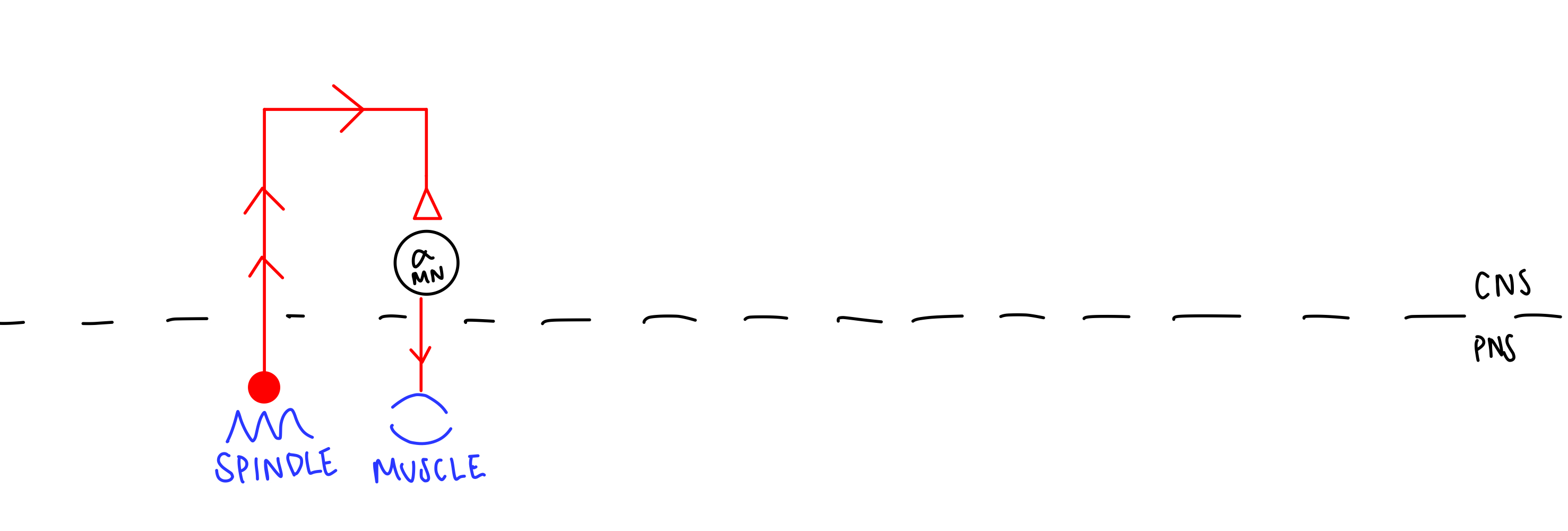
78
New cards
you’re bench pressing and build up too much force on the pec major muscle
* what receptor detects this?
* what will happen?
* what receptor detects this?
* what will happen?
* GTO
* inhibition of the pec major (keeping activity in a safe range)
* inhibition of the pec major (keeping activity in a safe range)
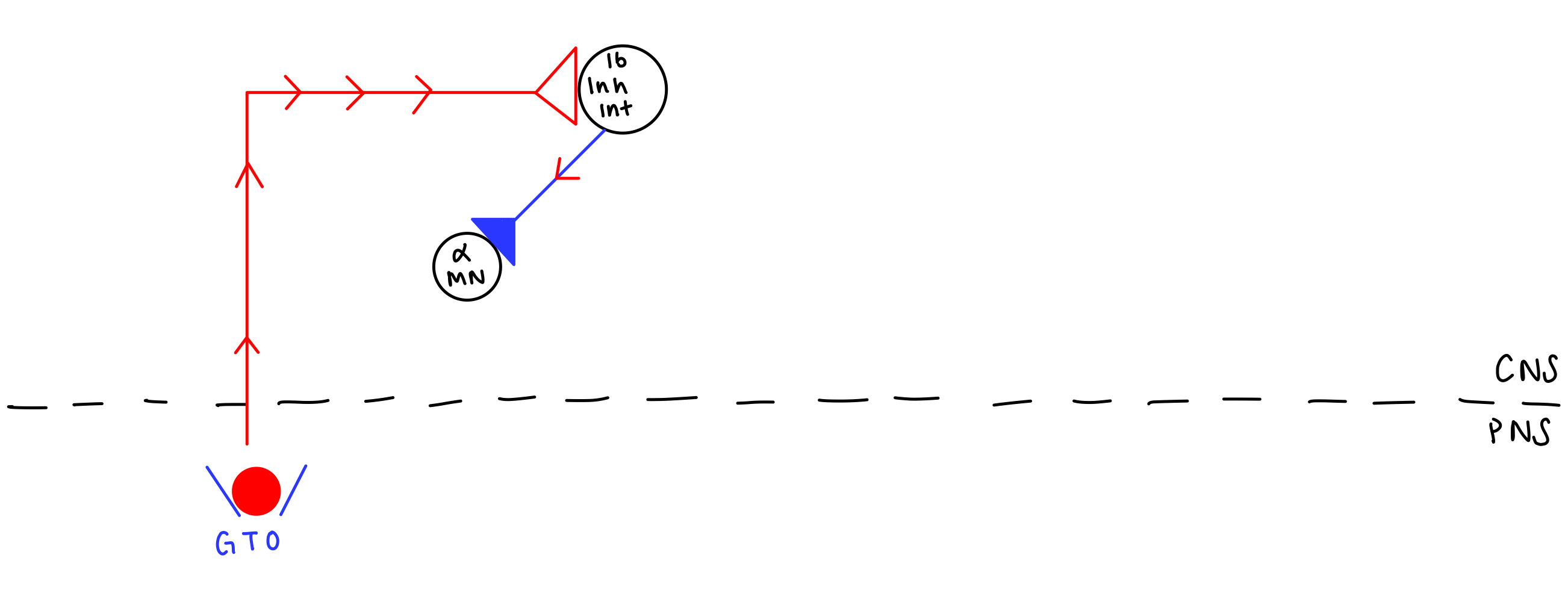
79
New cards
what type of inhibition doesn’t come from a specific peripheral receptor
* what interneuron does it use?
* what interneuron does it use?
recurrent inhibition
* renshaw cells
* renshaw cells

80
New cards
these protective reflexes modulate their activity based on where you step on a tack on your foot
* what afferents?
* what’s the receptor?
* what afferents?
* what’s the receptor?
* III/IV afferents
* cutaneous receptors
\*\*\* can be excitation or inhibition
* cutaneous receptors
\*\*\* can be excitation or inhibition
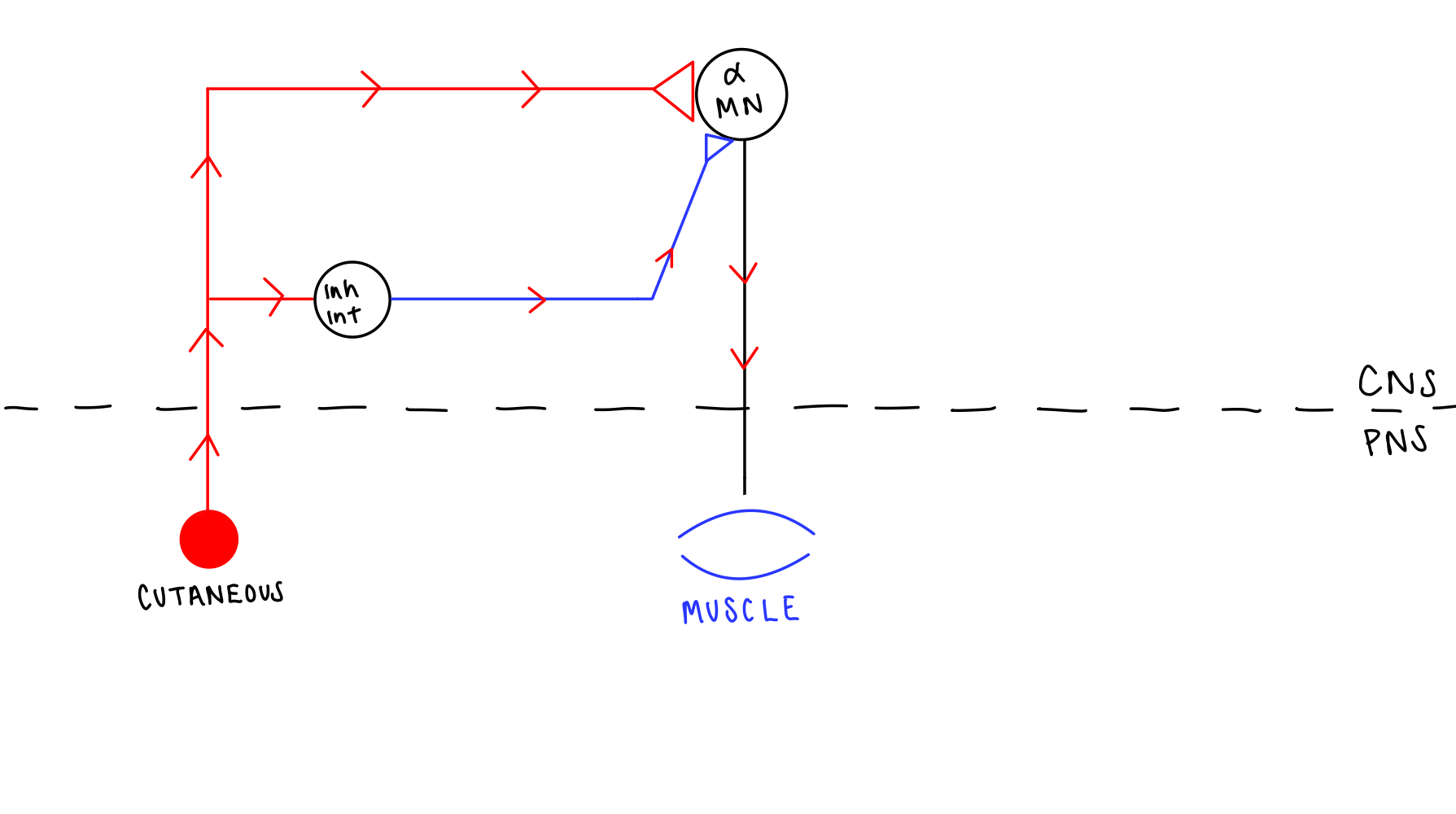
81
New cards
activating agonist while stretching antagonist is what PNF stretch?
* this is what spinal circuit?
* how would you do this if you wanted to stretch the tibialis anterior?
* this is what spinal circuit?
* how would you do this if you wanted to stretch the tibialis anterior?
agonist contract
* reciprocal inhibition
* contract gastrocnemius while stretching TA at the same time
\*\*\*inhibition will always be the muscle that is being stretched
* reciprocal inhibition
* contract gastrocnemius while stretching TA at the same time
\*\*\*inhibition will always be the muscle that is being stretched
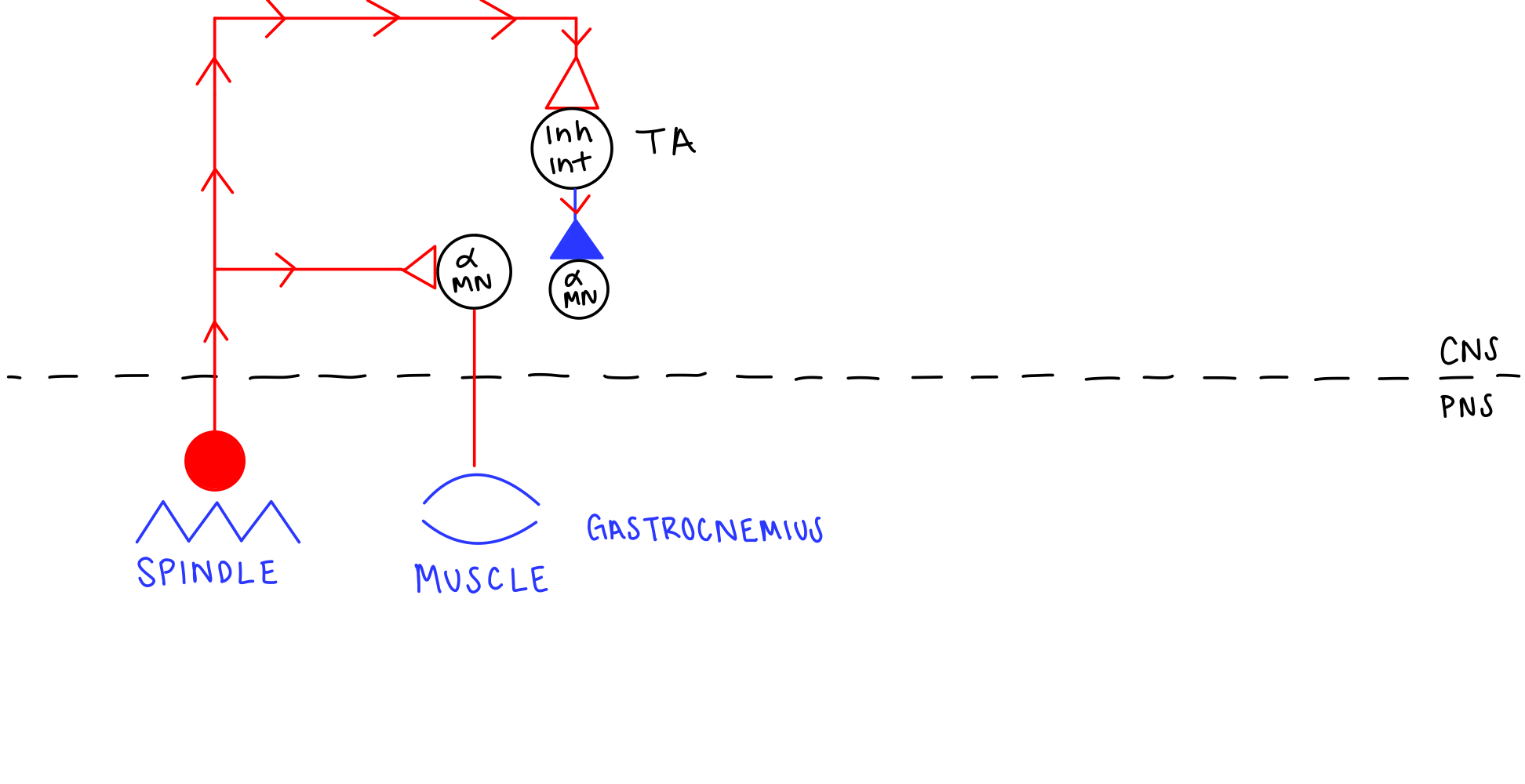
82
New cards
you step on a sharp object on your R foot
* what reflex circuit will this evoke?
* what will happen?
* what reflex circuit will this evoke?
* what will happen?
* crossed extension reflex
* flex R hamstring, extend L quadricep
* flex R hamstring, extend L quadricep
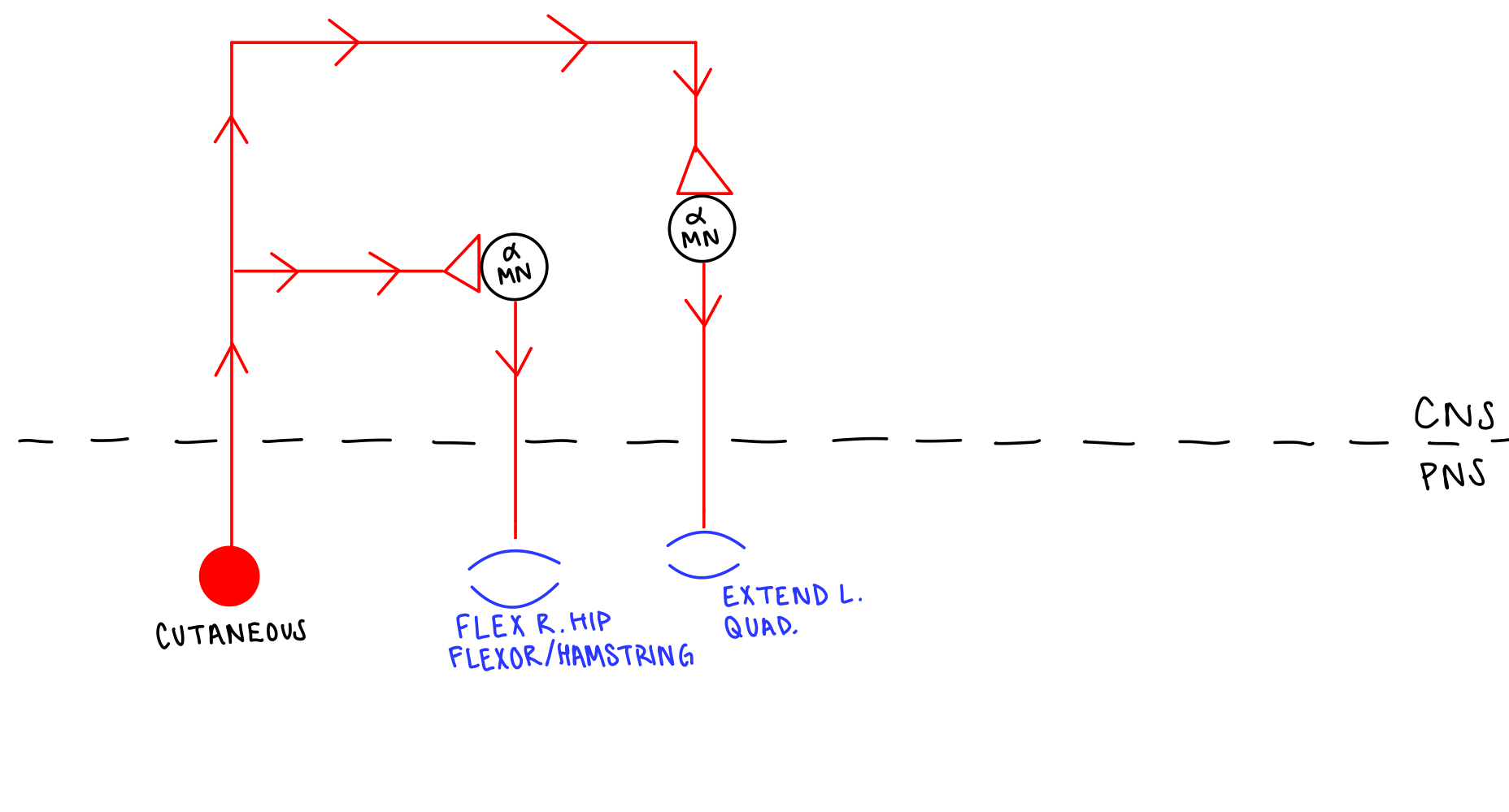
83
New cards
central pattern generators
a network of neurons capable of generating rhythmic patterns of motor activity in the absence of rhythmic sensory or central input
* snake moving back and forth to move
* snake moving back and forth to move
84
New cards
what are the 5 receptors of the vestibular system?
* utricle
* saccule
* 3 semicircular canals
* saccule
* 3 semicircular canals
85
New cards
what do utricle and saccule detect?
linear acceleration
86
New cards
what do the 3 semicircular canals detect?
angular motion
87
New cards
vestibular-ocular reflex
keeps the eyes stable when the head moves
88
New cards
how can the vestibular system be artificially stimulated?
through galvanic stimulation
89
New cards
what region was stimulated in the study about cats discussed in the lecture recording?
mesencephalic locomotor region (MLR)
90
New cards
nystagmus
voluntary/involuntary eye movement
* spinning/saccades
* spinning/saccades
91
New cards
vertigo
inadvertently experiencing/perceiving motion
* colds, flu, drinking, MS
* colds, flu, drinking, MS
92
New cards
cornea
covers eye
93
New cards
iris
controls the amount of light let in
94
New cards
rods
color insensitive and work in dim light
* 120 million
* 120 million
95
New cards
cones
detect color vision and work in bright light
* 6 million
* 6 million
96
New cards
visual system pathway
light enters the eye through the cornea and iris → photoreceptors (bright light: cones) (dim light: rods) → bipolar and horizontal cells → ganglion cells → lateral geniculate nucleus via optic nerve → visual cortex (through monocular or binocular layer) → simple cells → complex cells → see image
97
New cards
monocular deprivation
covering one eye of a newborn kitten removes virtually all connections to the visual cortex for that eye
98
New cards
strabismus
cutting a lateral muscle in the eye of baby kittens (wall-eyed) removes the bilateral function of the eyes
99
New cards
hemispatial neglect
awareness of sensory information (visual, auditory, kinesthetic) on the left side of the body is diminished and can lead to difficulties in balance and performing daily activities of living
* 45% of patients with TBI to the R hemisphere
* 45% of patients with TBI to the R hemisphere
100
New cards
what is the sensory pathway of reaching out & touching an object that is hot/cold with your hand or upper body limb?
touch receptor → enters the dorsal horn of the spinal cord ipsilaterally (same side the signal occurred) → cuneate nucleus tract within the anterolateral tract → travels rostrally to the medulla → decussates at the sensory decussation → continues contralaterally (opposite side the signal occurred) to the thalamus → area 3b